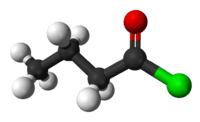Butyryl chloride
 | |
 | |
| Names | |
|---|---|
| IUPAC name
butanoyl chloride | |
| Other names
n-Butyryl chloride, C-4 Acyl halide | |
| Identifiers | |
| 141-75-3 | |
| ChemSpider | 8523 |
| EC-number | 205-498-5 |
| |
| Jmol-3D images | Image |
| PubChem | 8855 |
| |
| UN number | 2353 |
| Properties | |
| C4H7ClO | |
| Molar mass | 106.55 g/mol |
| Appearance | colorless |
| Odor | pungent chloride ordor |
| Density | 1.033g/cm3 |
| Melting point | −89 °C (−128 °F; 184 K) |
| Boiling point | 102 °C (216 °F; 375 K) |
| decomposition | |
| Solubility | miscible with ether |
| Refractive index (nD) |
1.412 |
| Hazards | |
| Main hazards | Reacts violently with water, flammable, corrosive |
| NFPA 704 | |
| Flash point | 21.7 °C (71.1 °F; 294.8 K) |
| Except where noted otherwise, data is given for materials in their standard state (at 25 °C (77 °F), 100 kPa) | |
| | |
| Infobox references | |
Butyryl chloride (also known as n-Butyryl chloride, butanoyl chloride, or C-4 Acyl halide) is an organic compound with the chemical formula C4H7ClO. Butyryl chloride is liquid at room temperature, has a colorless to light yellowish appearance and has an extremely strong pungent odor. Butyryl chloride is soluble in almost all aprotic organic solvents, but it decomposes violently by heating and spontaneously decomposes when exposed to moist air or water to form pure hydrochloric acid gas. It also reacts violently when mixed with strong oxidants, metals (especially iron), alkali metals, alkali earth metals, bases and wide range of organic substances such as amines, dimethyl sulfoxide, and alcohols. These reactions tend to result in explosions and fire; hence extreme caution must be taken when mixing with other substances. Butyryl Chloride belongs in the group of acyl halides which are involved in acylation process that introduce an acyl group (RCO-) into compounds.
Reactions
Derivatives of butyryl chloride are used in manufacturing pesticides, pharmaceuticals, perfume fixative, polymerization catalyst, and dyestuffs. Butyryl chloride is also commonly used as an intermediate for organic synthesis for the preparation of pharmaceuticals, agrochemicals, dyes, esters, and peroxide compounds.[1]
Health concerns and disposal
The chemical, physical, and toxological properties of butyryl chloride have not been thoroughly investigated. Butyryl chloride is known to be toxic and symptoms of exposure include: burning sensation at site of contact, coughing, wheezing, laryngitis, shortness of breath, headache, nausea, and vomiting. Inhaling can result in death from spasms, inflammation and edema of the larynx and bronchi, chemical pneumonitis, and pulmonary edema. It is extremely corrosive and destructive of tissues, especially mucous membranes, upper respiratory tract, eyes, and skin. Prolonged exposure and frequent contact is believed (but yet to be proven) to cause seizures and cancer. If butyryl chloride is ingested, vomiting should not be induced.
In case of fire, CO2 or foam extinguishers should be used instead of water. In case of spillage butyryl chloride can neutralized with sodium carbonate (soda ash) or calcium hydroxide (slaked lime).[2][3]
